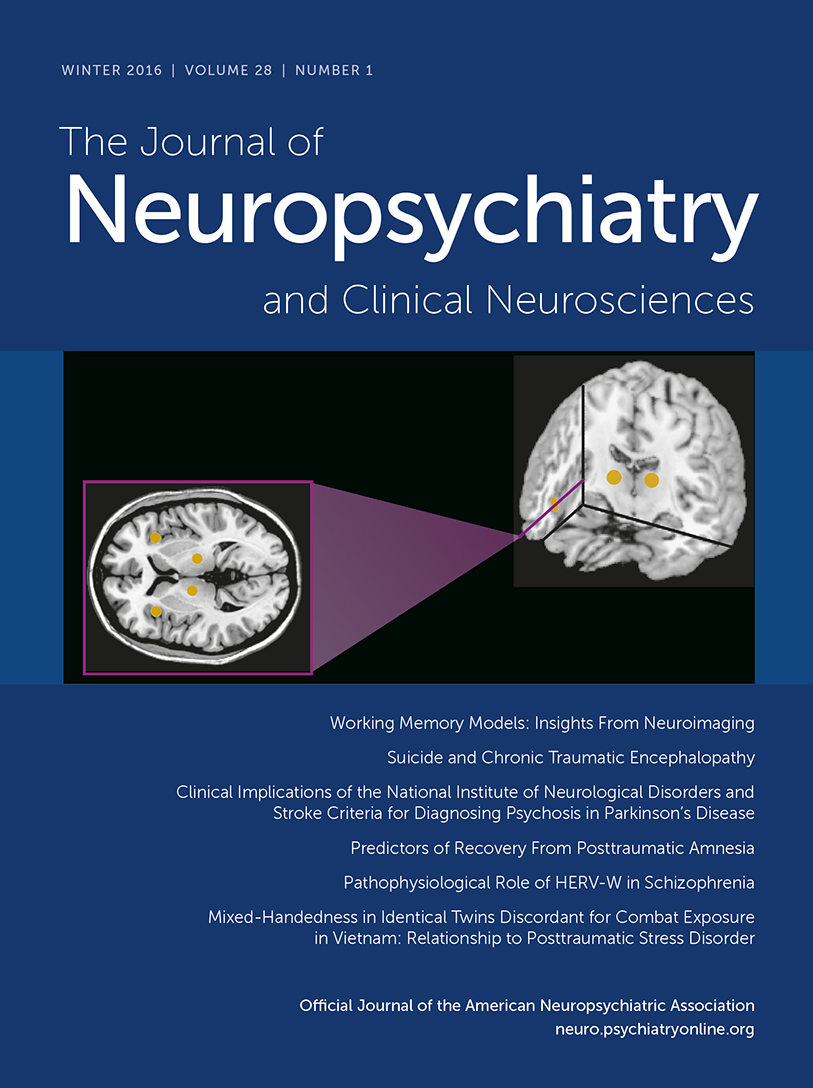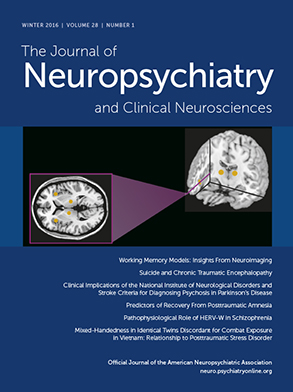To the Editor: Huntington’s disease (HD) is a neurodegenerative disorder characterized by abnormal choreatic movements, subcortical dementia, and psychiatric symptoms. Psychiatric disorders encountered in HD include major depressive disorder, anxiety disorders, or isolated symptoms such as apathy or irritability in 33%−76% of patients. Psychotic disorders affect 3%−11% of patients.
1 Although psychiatric symptomatology often precedes motor symptoms,
2 there is a dearth of data regarding psychiatric care in HD.
3 The case reported here refers to a patient suffering from HD, major depressive disorder, and psychotic symptomatology. This patient displayed a very poor tolerance to clozapine treatment and differential results with electroconvulsivotherapy (ECT) with remission of major depressive disorder symptoms and a slight improvement in motor symptoms, but there was no effect on psychotic symptoms.
Case Report
Mr. E, a 60-year-old patient with HD, was brought to the emergency department for marked anxiety, depressed mood, major sleep disturbance, and marked weight loss. He planned to commit suicide by defenestration. He claimed to be under the surveillance of a spy network that used earpieces and hacked his electronic devices. Interestingly, the patient was partially convinced by his ideas. Motor symptoms consisted of choreatic movements of the head and extremities and moderate dysarthria. Initial neuropsychiatric assessment is shown in
Table 1. The Mini-Mental State Examination z-score was calculated using norms provided by Crum et al.
4 Results on CT scan showed a moderate degree of generalized cerebral atrophy.
At age 40 years, the patient developed major depressive disorder associated with persecutory delusional symptoms. The duration of the episode led to the diagnosis of late-onset schizoaffective disorder. During 20 years of care, the disease showed a particular refractoriness to all psychopharmacologic strategies implemented (antidepressants, neuroleptics, atypical antipsychotics, and mood stabilizers). No family history of psychosis or neurologic disorders has been reported.
At age 59 years, the patient displayed abnormal writhing movements suggestive of HD, which prompted evaluation for this condition. Genetic testing found a CAG repeat size of 23 for the normal allele and 41 for the HD allele, thus confirming the diagnosis of HD.
When the patient was admitted, clozapine was introduced and was titrated up to 350 mg per day in association with mirtazapine. At a dosage of clozapine of 350 mg daily, the patient experienced acute mental confusion, circadian rhythm reversal, restlessness, and a worsening of dysarthria and abnormal movements. All side effects disappeared after the clozapine was stopped (Naranjo score=8). An ECT course was implemented, with 18 ECT sessions. At the 12th session, Mr. E’s symptoms were markedly improved, with complete disappearance of major depressive disorder symptoms and suicidal ideation. However, he was still having delusional ideas (
Table 1).
A continuation course and a maintenance course were decided: the frequency of sessions was progressively decreased to one session every 6 weeks. The patient was maintained with mirtazapine (30 mg per day). At 1 year later, no depressive relapse was observed but delusional symptoms remained unchanged (
Table 1).
Discussion
This patient’s presentation is remarkable for the long latency between symptom onset and identification of the underlying cause of the symptoms. The diagnosis of HD may explain, at least in part, the marked refractoriness of the patient’s psychotic and depressive symptoms to pharmacologic treatments. Although psychiatric symptoms are known to be prodromal symptoms of HD,
5 the very long latency between severe psychiatric symptoms and the onset of motor symptoms observed in this patient is uncommon. Nonetheless, the onset of symptoms suggestive of schizoaffective disorder at age 40 years should have prompted, in retrospect, evaluation for a neurologic cause of the patient’s psychiatric symptoms. Perhaps most noteworthy is the differential response of the patient’s psychotic and depressive symptoms to ECT.
Other case reports describing major depressive disorder treatment in patients with HD showed positive results with mirtazapine and fluoxetine contrary to tricyclic antidepressants. Atypical antipsychotic drugs, such as risperidone and clozapine,
6 showed good results for treating psychotic dimension. In this case, clozapine induced a worsening of motor symptoms with no efficacy on psychotic symptoms, which is contradictory to the data available in the literature.
There are 14 reports of patients with HD with affective symptoms treated by ECT
7 in the literature. ECT was effective and well tolerated in 13 of 14 cases. As for psychotic disorders, the five cases reported in the literature
8 show positive results of ECT. The available studies often lack standardized assessment of psychopathologic improvement. Here, validated psychiatric scales (Montgomery-Åsberg Depression Rating Scale, Brief Psychiatric Rating Scale–Expanded, and Clinical Global Impressions Scale) were used to assess response to ECT. The Unified Huntington's Disease Rating Scale,
9 which was developed as a clinical rating scale to assess four domains of clinical performance and capacity in HD: motor function, cognitive function, behavioral abnormalities, and functional capacity, was also used. To our knowledge, this case is the first to show a psychotic resistance to ECT in patients with HD. As for motor symptoms, these data provide clues for the safety of the procedure for nonpsychiatric features.
HD motor symptoms are linked to a massive loss of striatal GABAergic medium spiny neurons. One current hypothesis consists of the involvement of excitotoxic neuronal death mediated by altered glutamatergic neurotransmission.
10 Moreover, striatal medium spiny neurons expressing dopamine receptors are known to be mainly affected in the early stage of HD.
11 Altered dopamine signaling may then play a key role in the pathogenesis of HD. In this case, the patient displayed psychotic and affective symptoms at the prodromal stage of HD. One may speculate that mesocorticolimbic dopaminergic projection may be implicated in these early symptoms. The hyperdopaminergic state in mesolimbic regions known to be involved in delusional disorders may lead to the loss of long-range GABAergic projections from the ventral tegmental area, making these structures unresponsive to antipsychotic treatment and ECT. However, such a mechanism cannot be extended to the regions involved in affective symptoms,
12 in which a hypodopaminergic state—as well as a depletion in serotonin and norepinephrine—is observed. This may explain the differential response observed here, with potentially less severe GABAergic neuronal degeneration in the regions involved in affective symptoms, such as the long-range projections from the raphe nuclei. This leads to the hypothesis that the degenerative process may progress at various speeds according to the structures, or that slightly different degenerative processes are at work according to the affected structures. These hypotheses are, however, speculative because the imaging data from the patient show only a generalized cerebral atrophy. Large-scale neuroimaging studies are needed to identify the structural and functional neuroanatomic abnormalities in HD according to the various psychiatric symptoms observed.
This case report is the first to describe a refractory psychotic symptomatology to clozapine and ECT in a patient with HD. The differences with other case reports may be explained by the possible existence of subtypes of HD. Moreover, this case underscores the importance of psychiatrists to take into account the possibility of a primary organic disorder in late-onset and atypical disorders.

